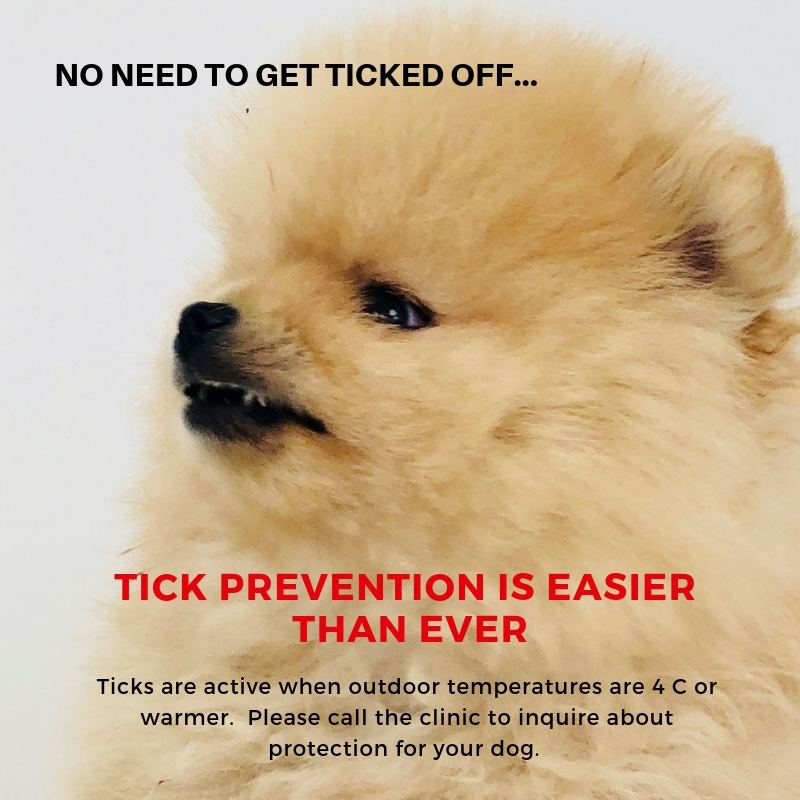I think we are all celebrating the official arrival of spring – grateful for more sunshine and warmer weather. Unfortunately, spring weather brings with it a potential pesky peril for pets…ticks.
Ticks are technically not insects; taxonomically classified closer to spiders and scorpions. In some respects, ticks are much less of a pain than other external parasites. They are not poisonous. They don’t infest our living quarters (as long as we don’t call a damp woodpile home). A tick bite is much less likely to cause a local allergic reaction than one from a mosquito or a flea. Severe or anaphylactic reactions to tick bites are rare. And yet, ticks still give most of us the heebie-jeebies. Read on to find out why.
To start, I think there’s just something about a bug that counts on us (or any of our furred family members) for a “blood meal” that drives up the ick meter. And so it should. Any time a critter engages in blood sucking, there is the potential for disease transmission (think mosquitos and malaria/heartworm or fleas and bubonic plague).

Tick Risk
As we start to see temperatures edge over 4 degrees C, ticks begin trolling for fresh meat in grassy and wooded areas, leaf litter, bushes and shrubs. Ticks have not only been increasing in number, but also expanding across the country in the past five years. This is mainly due to warmer temperatures and the dispersion of ticks on animal hosts like mice, raccoons, deer, etc. With the expansion of ticks, there has also been an increase in reported cases of tick-borne diseases in dogs.
The need to know list:

– Ticks are active when temperatures are above 4 C so prevention should be started in the early spring– Prevention is as easy as giving your pet a chewable treat.
– Ticks are being found in increasing numbers and in more locations in Mississauga and Etobicoke every year
– Ticks Spread Disease (*)
Tick Attack
As we start to see temperatures edge over 4 degrees C, ticks begin trolling for fresh meat in grassy, wooded areas, in leaf litter, shrubs or bushes. Interestingly, ticks don’t fly but rather “quest” by stretching out their forelegs to grab and cling onto passing animals. Ticks can spend up to 24 hours on their victim looking for the right feeding site. When a tick is ready to bite it grasps the skin and cuts in to the skin’s surface. The tick then inserts its feeding tube. The mechanics differ depending on the species of tick (some will secrete a cement-like substance that keeps them firmly attached during their ‘meal’, some ticks have barbs in the feeding tube that help to keep them attached). The feeding process can continue for 2-3 days. During that time, the tick engages in a kind of creepy back-washing that allows the transfer of disease from the tick to its victimWhen the tick completes the blood meal, it disengages and then drops off the host. Some ticks inject a kind of local anesthetic in to the skin so that person or animal can’t feel that the tick has attached itself. If the tick is in a sheltered spot, it can go completely unnoticed.
Ticks on a dog or cat are easy to miss. When ticks initially attach, they are very small; they grow considerably during the attachment period. As fastidious groomers, cats are less likely to present with ticks though they are not immune to ticks or the diseases that they carry.
When ticks initially attach, they are very small; they grow considerably during the attachment period. The feeding process continues for 2-7 days.

When the tick completes the blood meal, it disengages and then drops off the host.

Ticks: Nature’s Dirty Needle (*)
Most of the diseases that ticks can carry are zoonotic; meaning they cause infection in animals and humans. Of all the tick borne illnesses, Lime Disease certainly gets the most press, but ticks are known to carry a whole host of other infectious agents. Among those that can be found in Southern Ontario are the bacterium that causes Human Granulocytic Anaplasmosis, the protozoal parasite that causes human Babesiosis and organisms that can cause encephalitis. The Public Health Agency of Canada details these diseases on their website – see this article for details: Health Canada Report on Communicable Diseases
Historically, the risk of contracting these diseases in Canada was said to be low. However, that picture is definitely changing. Experts suggest that increasing climatic temperatures are leading to the spread of ticks to more northern areas, including Southern Ontario.
This Scientific America article presents a rather ghastly picture – referring to ticks as nature’s dirty needle.
PREVENTION IS EASY
If you ever have concerns about your pet’s health, don’t hesitate to call the clinic for advice. We are here and happy to help.
Fortunately, with the advent of new preventives, tick control is easier and more effective then ever. Combination flea and tick prevention is now as easy as giving your dog a chewable treat either every 30 or 90 days (depending on the preventative product you choose).
If your pet is healthy and his or her annual exam is up to date at our clinic and you will not need to book a doctor’s appointment to pick up flea and tick prevention. Call the clinic for more information.
If you ever have concerns about your pet’s health, don’t hesitate to call the clinic for advice. We are here and happy to help.

Danya Terp
Danya is a veterinary technician and clinic administrator at the Renforth Veterinary Clinic. Writing has been one of Danya’s life long passions. She is the author of the clinic’s website content and is working towards certification as a veterinary journalist.

